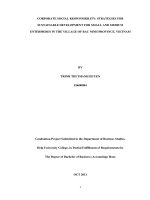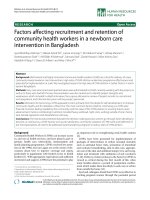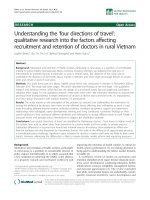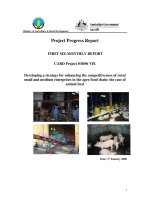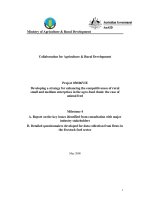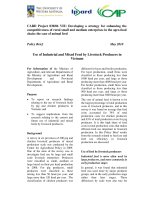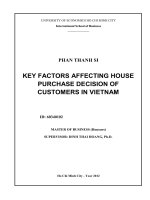Factors affecting asset investment decisions of state-owned enterprises in the northwest of Viet Nam
Bạn đang xem bản rút gọn của tài liệu. Xem và tải ngay bản đầy đủ của tài liệu tại đây (660.21 KB, 10 trang )
FACTORS AFFECTING ASSET INVESTMENT DECISIONS
OF STATE-OWNED ENTERPRISES IN THE NORTHWEST
OF VIET NAM
PhD. Trinh Mai Van,
Department of Scientific Management, National Economics University (NEU), Hanoi,
PhD. Phan Hong Mai, Scholl of Finance and Banking, NEU
MSc. Dao Thi Van Anh,
Department of Economics, Tay Bac University, Son La, Viet Nam
Abstract:
Reality, State - owned enterprises in the Northwest of Viet Nam tend to invest more
in width, but the investment decisions of enterprise's assets are not based on the
profitability of capital or assets. The paper focuses on the factors that influence the
investment decisions to assets of state-owned enterprises. The subjects in this study are
from the provinces of the Northwest which are all similar in the level of regional economic
development and technology manufacturing. Using data of state - owned enterprises in the
Northwest from 2012 to 2015, apply linear regression techniques with the smallest
minimum estimation model, but the data is aggregated as panel data, the authors find that
assets investment decisions of state - owned enterprises in the Northwest depend on capital
investment of state, sales and borrowing or appropriated capital in the business process.
Keywords: asset investment decision, influence factor, state-owned enterprises
1. Introduction
Asset acts as a labor resource in the business process. They are considered as
material and technical facilities which play an important role in production and business
activities, as a condition for enterprises to increase labor productivity and develop the
national economy. On the micro perspective, machinery and equipment, manufacturing
technology process... are the factors determining the size and production capacity of
enterprises. On the macro perspective, physical and technical infrastructure will contribute
to assessing the strength of the national economy (Karlsson et al., 2014). Exactly, it can be
said that asset is very important for businesses.
In the recent 3 years, the rate of state-owned enterprises in localities went bankrupt
and dissolved is quite high, in Son La, Dien Bien, Lai Chau and Hoa Binh province, it is
about 20% of the total state-owned enterprises in local. This shows that business
performance as well as their annual contribution to GDP is very low. Besides, these
enterprises are facing serious difficulties such as lack of capital to invest, renew long-term
assets, low productivity, lack of experience in marketing, investment decisions making.
Among these difficulties, the lack of financial resources and experience in asset
investment decisions are the most serious problems. Investing in ineffective assets can
have a big impact on profit and business results of enterprises. In contrast, investing in
199
effective assets will help businesses pass difficulties and increase profits. In fact, local
SOEs are mostly small and medium size, which are difficult to get credits from
commercial banks because the banks think that their profits are difficult to offset credit
risk. Accordingly, how to use capital and make assets investment decisions effectively
becomes more important for businesses.
Many enterprises, especially state-owned enterprises in the Northwest region also
invest in assets but their profit is low and assets are used ineffectively. In particular, the
long-term assets investment do not meet the requirements of large-scale production, high
quality, automation and modernization. This is the reason why the production capacity of
these enterprises is still low and business results is not high, expressed by the profitability
coefficient of state-owned enterprises Northwest region in the period 2012 - 2014 only
about 0.08 to 0.1. Therefore, clarify the factors that affect assets investment decisions, as
well as clarify the relationship of these decisions with the business results of the
enterprises is necessary in the current conditions.
This will really help managers in general and state-owned enterprises in the
northwestern region in particular to perform the task of corporate finance effectively. At
the same time, it is the basis for the State issue suitable policies, support enterprises to
invest long-term assets as desired, achieve the target.
* Overview of previous studies
The search for factors affecting asset investment is quite limited and many
arguments. Previous studies (Jahera John et al., 1996); (Panda, Swati, 2012); (Lenka,
2014) mainly focus on identifying factors affecting capital structure which is an
important resource for the development of enterprises. There are many studies that
selected investment decision is the object of study, but the authors focus only on the
factors that affect the investment decisions based on the theory of individual investment
behavior, instead of studying the investment decisions of the business. For the asset of
business which is a form of expression‘s capital, is considered in terms of: Improve
effective use of assets (Brand Strategy, 2003), solutions for effective asset management
(Moore Ron, 2006); asset depreciation method (O'Bannon Isaac, 2011) rather than
factors affecting asset investment.
From different perspectives, there are many researchers who have studied the
investment decisions of enterprises or general assets in enterprises. However, so far
researchers rarely choose asset investment as the main object of their research. When
previous studies investigated the process of investment decision making in general
enterprise, they showed that investment decision is a process of many standards and many
factors (Enoma and Mustapha, 2010). These factors include not only the economic and risk
factors but also the political, social and government‘s regulations (Enoma and Mustapha,
2010). It means that there are many factors, both internal and external, that prevent the
asset investment process, but they have not yet been fully and uniformly recognized.
Therefore, an in-depth study of the factors affecting assets investment decisions is
200
necessary to help managers make investment decisions correctly, it contributes to ensure
long-term and sustainable development of enterprises.
* Factors affect on the assets investment decisions of the business
There are many factors that influence the assets investment decisions of business,
there are direct factors, but also there are indirect and linear factors that affect the
investment decisions. In addition, the nature and level of impact‘s factors are not the same.
There are some positive factors that help businesses make more investment decisions while
some factors negatively impact. However, the author focuses only on the following factors:
- Sales growth:
Eisner (1960) has shown that sale growth has the opposite effect on enterprise‘s
investment decisions. It means that enterprises have higher sale, the less investment. In
Vietnam, in 2008, Le Khuong Ninh et al. indicated that the investments of non-state
enterprises also depend on the growth of sale and profitability. The larger the sales, the
greater the demand for investment, and this is opposed to Eisner's theory (1960).
- Equity/ Owner's equity:
The study of Budina et al. (2000) confirms that the investment of small enterprises
is more influenced by the equity than the large enterprises. When Budina et al. (2000)
argued that equity positively correlated to the investment decision of the enterprise, it
means that the more equity enterprise has, the more enterprise invests. But then, Gelos and
Werner (2002) argued that equity negatively correlated.
In Vietnam, the regression model of Le Khuong Ninh et al. (2008) showed that the
investment of non-state enterprises in Kien Giang depends largely on equity or the rate of
profit last year divided by fixed assets next year and it is entirely consistent with the
theory, consistent with the study of Budina et al. (2000). Meanwhile, the equity variable in
the model of Le Bao Lam and Le Van Huong (2010) about investment decision of
enterprises in Tien Giang province has a negative coefficient and statistical significance at
level 5 % is consistent with the result of Gelos and Werner (2002).
- Debt payable:
Le Khuong Ninh et al. (2008) have been very successful in finding new factors
when they research about the non-state sector in Kien Giang, these include: loans and
ability to increase ground. The authors argued that the loan is also a factor positive
influencing the investment decisions of these enterprises.
- Profitability of equity (ROE):
Profitability of equity (ROE) measures the profitability of each capital that invested
by the owner. As a result, the higher ROE is, the better the equity is used. Le Bao Lam et
al. (2010) confirmed that ROE does not affect on investment decisions of enterprises in
Tien Giang province.
- Ownership of enterprise:
Besley (1995) suggested that the ownership of enterprise influenced the investment
decisions of enterprises. In Vietnam, Le Bao Lam et al. (2010) also confirmed the positive
201
relationship of this factor with the investment decision of the enterprise. However, the
subjects of Besley (1995) or Le Bao Lam et al (2010) are non-state enterprises, of which a
large number of these enterprises are private that are very dynamic, flexible and they rarely
lose investment opportunities. In comparison with other types of enterprises, private
enterprises tend to invest more. Therefore, the authors suggest that the results of these
studies should be do again for state-owned enterprises.
2. Method
* Data set:
According to the Business Law in 2014, SOEs are enterprises with 100% state
capital. With this classification, the article uses secondary information as the annual
financial reports in the period 2012-2015 in the Northwest, Viet Nam. There are 38 stateowned enterprises in Son La, Dien Bien, Lai Chau and Hoa Binh province of Northwest.
* Research Methods: Use panel data with the support of Stata software. Especially,
this study uses the least squares estimation model (OLS) but the data is synthesized as
array for 4 years and the factors which to be studied were mainly the endogenous factors in
the enterprise, they were collected from the characteristics and results from the actual
production and business activities of state-owned enterprises in the Northwest region.
* Variables of the model: The purpose of model is to detect factors that affect the
asset investment decisions of the business. The research model has the form of the
equation as follows:
Where: i = 1,2, ..., n and t = 2012, ..., 2015.
Dependent variables and independent variables are described in the table 1.
Table 1. Description of variables
Variables
Variable’s name
TS
Total assets
Total asset value, calculated at the end of year, target No.
270 on the balance sheet accounting
dt
Sales
Total sales value in each year, target No. 10 on the
balance sheet accounting
dtvcsh
Equity
Equity at the end of the year minus the beginning of the year
dtnpt
Debt payable
Debt payable at the end of the year minus the beginning
of the year
dtroe
Profitability
equity
Description
of ROE of the next year minus the previous year, ROE measured
by the quotient of net profit after tax and equity value
loaihinhdn Type of business
a dummy variable that equals one if the type of business
is joint stock company (is classified according to Business
Law in 2014), and zero otherwise.
Source: Research by the authors
202
3. Results
3.1. Descriptive statistics of variables
In order to have a comprehensive understanding of factors on asset investment
decisions, the general descriptive statistics of variables are shown in Table 2.
Table 2. Descriptive statistics of variables
Variable
Obs
Mean
Std.Dev.
Min
Max
TS
152
72.1
72.1
1.77
887
dt
152
31.0
33.8
0.0024
183
dtnpt
114
1.28
18.5
-57.5
153
dtvcsh
114
13.3
61.5
-175
510
dtroe
114
-0.00037
0.138
-0.83
0.773
loaihinhdn
152
1.578947
0.4953601
1
2
Source: Research by the authors
Most of the variables in the model have a high difference between the highest value
and the lowest value. The total asset variable represents the size of enterprises, with the
smallest value was 1.77 billion VND and the largest value was 887 billion VND with an
average value was 72.1 billion VND showing a big difference between samples. The sale
variable represents the sales of enterprises each year, the average value was 31 billion
VND, the lowest value was 239 VND and the highest was 183 billion VND. This variable
represents the difference in sales between enterprises was quite large. The Debt payable
variable reflects the ability of enterprises to borrow loans, the smallest value of variable
was negative (-) while the highest value was up to 153 billion VND, it means that some
enterprises had paid old debts without additional mobilization and some businesses still
borrowed large amounts of capital. The equity variable shows the growth of equity over the
years. The difference between the highest value and the lowest value of the variable is also
great, it shows that every year there were enterprises that increased equity but there were
also enterprises that have reduced equity. Equity decreased because business result was
low, it made negative profit. The Profitability of equity variable reflected the increase in
profitability from equity, the lowest value was -0.83 and the highest was 0.77, it showed
that the profitability of some enterprises increased at a high level. But there were also
businesses had low profitability. The Type of business variable received only 2 values of 1
and 0, corresponding to two popular types of state-owned enterprises in the Northwest:
joint-stock company and limited liability company.
3.2. Correlation analysis
This study uses correlation analysis to determine the correlation coefficients of the
independent and dependent variables as well as the collinearity of the independent
variables. First, Pearson's correlation analysis is to examine the correlation‘s variable and
to avoid the problem of collinearity. As the results shown in table 3, the correlation
coefficient matrix of the assets investment variables of state owned enterprises in the
203
Northwest is below 0.18. Correlation coefficients between variables are approaching to
zero, it means that the independent variables in the model have no linear relationship with
each other.
Table 3. Correlation matrix
dt
dtvcsh
dtno
dtroe
dt
1.0000
dtvcsh
-0.1103
1.0000
dtno
-0.0708
-0.1778
1.0000
dtroe
0.0540
-0.0114
0.0209
1.0000
loaihinhdn
-0.1149
0.1829
-0.0493
0.0399
loaihinhdn
1.0000
Source: Research by the authors
Moreover, this study conducts a test on the VIFs (variance inflation factors) to
examine the linearity of the independent variables, the results shown in table 4. The test
results indicate that the VIF values for all the independent variables in this model are
below 1.08. These coefficients are all around 1.01 to 1.08, indicating there is no
collinearity problem.
Table 4. Variance inflation factors
Variable
VIF
1/VIF
dtvcsh
1.08
0.926857
loaihinhdn
1.05
0.956872
dtnpt
1.04
0.958877
dt
1.03
0.968710
dtroe
1.01
0.994163
Mean VIF
1.04
Source: Research by the authors
3.3. Empirical results
Estimated results of the model are shown in the table 3.
According to F value testing, the regression model is statistically significant at 1%.
This means that the explanatory variables in the model affect on the variability of the
dependent variable. The independent variables in this model can explain 50.8% of
variation in the dependent variable. The remaining variation of the dependent variable can
be explained by other factors that the authors do not or no research.
Table 5 shows that the significance level of P-value (sig.) of Equity and Debts
payable variables are less than 1% and Sale variable is less than 5%. Therefore, we
conclude that these variables are significant in the model. The remaining variables:
Profitability and Type of business are not statistically significant. That means that the
204
Equity, Debts payable and Sale are factors that influence the assets investment decisions of
the enterprises. Specifically:
Sale variable: It has a positive coefficient and a statistical significance is 10%. This
result contradicts Eisner's study (1960), but it is similar to Le Khuong Ninh‘s study (2008)
in Vietnam. It means that the higher the sales of enterprises are, the more assets enterprises
invest to expand the size.
Table 5. Estimated results of the model
Variables
Coefficients
Sales
0.6490652**
(0.2803755)
Equity
1.625756***
(0.162144)
Debts payable
2.159756 ***
(0.5301604)
Profitability
4.84e+09
(6.95e+10)
Type of business
1.29e+10
(1.98e+10)
Intercept
1.50e+10
(3.44e+10)
Standard errors are given in parentheses.
Dependent variable: Total assets
Observations: 152.
2
R = 50,8%.
*p < 10%
**p < 5%
F(5, 108)
=
***p < 1%
22.30***
Source: Research by the authors
Equity variable: It has a positive coefficient and is statistically significant at 1%,
this result is perfectly consistent with the theory. It is also consistent with result of Budina
et al. (2000) that the higher the equity is, the more investment in assets business has. This
result is consistent with the actual situation of state-owned enterprises in the Northwest,
because these enterprises use state capital to invest, so the size of capital is not high and
the ability to borrow is low, the demand for investment to expand the size of production
and business mainly depends on the equity.
Debts payable variable: The regression coefficient of this variable is positive and is
very large at 2.16. This shows that the impact of the loan amount and the debt on the
investment of the business is very large. It is consistent with the result of research by Le
Khuong Ninh et al. (2010), which means that the higher the debt is, the more investment in
assets the state-owned enterprises in the Northwest have.
205
Research results show that the Debts payable and Equity are the factors influencing
the investment decisions of enterprises. From this it can be seen that the demand for
investing to expand the size of state-owned enterprise in the Northwest is very large,
showing that whenever there is an opportunity to increase sale, equity or debt, these firms
tend to invest more assets. This is perfectly suitable with actual situation in these areas,
which are state-owned enterprises with small and medium sizes, so whenever they have the
opportunity to increase the capital, they tend to invest in assets. However, the results of
research can also confirm that businesses are focused on developing more width.
Variables have no meaning in the model: Type of business and Profitability are
factors that have a low or no affection on the assets investment decisions of the firms.
State-owned enterprises in the Northwest are joint-stock companies and one-member
limited liability companies. The results show that whether they are joint stock
companies or limited companies, the type of business does not affect the investment
decisions of these firms. In addition, the profitability in general and the profitability of
equity in particular does not have much affection on the assets investment decisions of
the business because most of these businesses have low business performance, it makes
indicator reflect the profitability is not high, so it does not affect the assets investment
decisions of enterprises.
Thus, we can assume that the asset investment decision of state-owned enterprises
does not depend on the type of enterprise and profitability of equity, but it depends on the
amount of capital invested by the state, sales and loans or the capital that the enterprise is
occupied in the business process..
4. Conclusions and recommendations
With a set of data on state-owned enterprises in the Northwest from 2012 to 2015,
we used the regression model and were found that there were 3 statistically significant
variables influence the assets investment decisions of these enterprises. All of 3 variables:
Sale , Equity and Debts payable have the same relationship with assets investment
decisions of enterprises. Apart from the three variables that are statistically significant and
affect on the assets investment decision of the firms, other factors such as the Type of
business and Profitability are not statistically significant, so there are little or no affection
on the assets investment decisions of enterprises.
Based on the findings of the study, in order to improve the business performance of
state-owned enterprises, to contribute to socio-economic development in the Northwest,
the authors recommend some solutions as follows:
* For businesses:
+ The results showed that the demand for asset investment of enterprises is very
large while the capital is still limited. In order to mobilize capital for investment,
enterprises need to be more active, actively approach and actively seek capital from
different channels of capital mobilization, avoid depending on or waiting on state capital
for investment.
206
+ The results also showed that state-owned enterprises in the Northwest of Viet
Nam are focusing more on development in width, thus it is nescesary to raising capital to
meet the need for asset investment. However, in order to enterprises develop sustainably in
the future, enterprises should also pay attention to develop in depth.
+ For investment in assets, especially long-term assets, which are used for a long
time, time to recover capital for a long time, so investment decision in long-term assets
should be depend on profitability of these assets.
* For local government:
+ Create a transparent, flexible business environment and support enterprises in
public services to help businesses save transaction costs and create opportunities for
enterprises to invest in depth.
+ It is necessary to carry out regular surveys to collect comments, to capture the
situation of production and business as well as the difficulties that enterprises are
encountering. So that, there are grounds and orientation to build policies to support
enterprises on time.
+ From the research results, we can be seen that the investment demand of
enterprises in the Northwest are very large, showing that whenever there is opportunity to
increase sale or equity and debt, enterprises to tend to invest in more assets. Therefore, the
assistance about investment capital for enterprises needs to be considered. However, in
order to avoid inefficient investment, it is necessary to further assess the effectiveness of
their capital use.
+ The results show that the past time, the credit system and local banks have met
the capital demand for business operations. However, in order to businesses increase their
capital, it is necessary to further improve the performance of the credit system. The
purpose is to help businesses reach deeper loans with reasonable costs and simple loan
procedures.
5. References
1. Abel and Eberly (1994), A Unified Model of Investment Under Uncertainly,
American Economic Review.
2. Alzharani Abdullah Mohammed, Che-Ahmad Ayoib, Aljaaidi Khaled Salmen,
(2012), Factors associated with firm performance: Empirical evidence from the kingdom
of Saudi Arabia, Accounting &Taxation, 4.2: 49-56.
3. Besley, (1995), Property rights and investment incentives: Thoery and evidence
from Ghana, Journal of Political Economy.
4. Budina, Garretsen, E.De Jong (2000), Liquidity constrains and investment in
transition economics: the case of Bulgaria, Economics of Transition.
5. Caballero, Ricardo (1991), Competition and the Non-Robustness of Investment
Uncertainly Relationship, American Economic Review.
207
6. Eisner, Robert và Robert H. Strotz (1963), Determinants of Business Fixed
Investment, in Commission on Money and Credit, Impacts of Monetary Policy, 59-337,
Prentice-Hall.
7. Le Khuong Ninh and Pham Le Thong, Le Tan Nghiem, Phan Anh Tu, Huynh
Viet Khai (2008), Analysis of factors influencing investment decision of non-state
enterprises in Kien Giang, Science 2008: 9, Can Tho University.
8. Piotr Bialowolski và Dorota Weziak-Bialowolska (2014), External factors
affecting investment decisions of companies, Economics: The Open-Access, OpenAssessment E-Journal, vol.8: 1-21.
208
